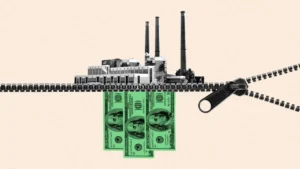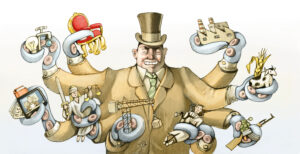The Insider’s Economic Dictionary: S Is for Saint-Simon
Sex: The topic that has proved strong enough to displace religious and academic discussion about property and wealth as the driving force in human affairs and evolution.
By Michael HudsonThis piece first appeared at economist Michael Hudson’s website. See the rest of the Insider’s Economic Dictionary here.S-curve
: The typical shape of growth in nature, such as human beings whose height tapers off as they reach maturity. They also typify most business cycles, which taper off after an upswing as employment, raw-materials and resource limits are approached and wages and commodity prices rise, slowing profits. The demand for specific products likewise tapers off as markets become saturated. Meanwhile, the fact that financial claims and debts tend to grow at compound interest means that financial dynamics tend to outrun the S-curve of production and consumption, creating business crises which end the upswing.
Saint-Simon, Claude Henry de (1760-1825): French reformer best known for recognizing the need to replace debt relations by turning saving into equity (stock) investment. Among his followers, the Pereire brothers helped create the Credit Mobilier basically as a mutual fund. With less effect, St.-Simon sought to abolish inheritance so that people would possess only the fruits of their own labor.
Savings: Savings consist of cash on hand (“hoarding”), direct investment in real estate or even fine arts, and financial claims for payment (stocks and bonds). As such, the term “savings” often is used as a synonym for wealth. Keynes viewed it passively, as non-spending, but financial savings are the mirror image of debt, as one party’s savings take the form of another party’s debts. (See Propensity to Save.) (Net worth is the excess of assets over debts, and appears on the liabilities side of the balance sheet.) Gross savings equal the sum of an economy’s debts and financial claims, which are called “indirect investment” to distinguish them from direct tangible investment in plant and equipment, research and development. Savings and debts thus tend to grow exponentially together through the accrual of interest. (See Compound Interest.)
Not all saving is voluntary or available for actual spending. For example, when firms “age their bills” by delaying payment, these unpaid debts create “savings” on the part of their suppliers, who accumulate claims for unpaid bills. (This forced saving has driven most of the small book publishers and CD music companies out of business in recent years.) The largest category of forced saving is that of pension-fund capitalism and Social Security.
Say’s Law: Named for the French liberal economist Jean-Baptiste Say (1767-1832), this “law” states that payments by producers to their employees and suppliers are spent reciprocally to buy the products of these producers. In popular terms, “Supply creates its own demand.” If this version of circular flow were true, there would be no business cycles or depressions. John Maynard Keynes accordingly devoted a large part of his General Theory (1936) to explain why this circular flow was interrupted, and blamed the financial system.
Science of assumptions: An oxymoron in which the criterion for acceptability of a discipline are whether its assumptions are logically consistent, without regard to whether or not they are realistic. The result tends to be circular reasoning based on tautological definitions. See Dismal Science, Junk Science and Neoclassical Economics. Antithesis: Reality economics.
Scientology, economic: In the sphere of academia, economic scientology is to science as astrology is to astronomy. The term refers to the love of scientific modes of exposition by non-scientists; the attempt by non-scientists to ape the superficial trappings of science by using complex mathematical formulae, but without the realistic empirical and statistical dimension that characterizes the physical sciences. As in the sphere of religious scientology promoted by the science fiction writer L. Ron Hubbard, the criterion for judging economic scientology is not its worldly reality but simply the degree to which its assumptions are logically consistent with one another. At the hands of neoliberals, these assumptions reflect a static and strongly right-wing, anti-labor polemical worldview. (See Nobel Prize.)
Serfdom: The final stage of breakdown of the oligarchic Roman Empire, when debt and warfare had reduced much of the population to debt bondage, stripping the economy of money and the government of its ability to tax the wealthy creditors and landowners, leading to adulteration of the coinage and a reversion of economic life to barter. The major economic units to survive were the landed estates of leading oligarchs and the Church. Economic status became fixed, tying cultivators to the land as serfs as Western European economies degenerated into land-based medieval-style monarchies and manors under feudal knights and warlords.
Sex: The topic that has proved strong enough to displace religious and academic discussion about property and wealth as the driving force in human affairs and evolution.
Sharia law: Much as medieval Christian law legitimized the charging of commercial “interest” and agio, Moslem law developed the idea of murabaha banking to enable usury to enter through the back door, by permitting creditors to taking their returns as a proportion of the borrower’s gain. (See agio, murabaha.) Lacking Christian financial laws of their own, Ferdinand and Isabella structured their investment in Christopher Columbus’s voyages of discovery and rapine as a sharia loan.
Single Tax: An exclusive tax levied on the land’s rental value, advocated first by the French Physiocrats (see Economists) and later by Henry George. By logical extension the tax also would fall on other economic rent not earned by the active efforts of its recipients but simply a property claim on revenue created by nature (land sites or monopolies) and given value by the prosperity of the community.
Sinking fund: A fund set aside by Britain’s Parliament in the late 18th century to pay off the national debt by investing in private-sector bonds and re-investing their interest receipts so that the savings principal would accumulate at compound interest, doubling and redoubling until it reached a magnitude sufficient to pay off the entire national debt. In practice Parliament could not resist raiding the fund and using it for the main purpose for which politicians spent money in those days – to wage war.
A recent version of the sinking fund was developed by Alan Greenspan in 1982 by imposing forced saving in the form of prepayment of U.S. taxes by the lowest employee-income brackets, ostensibly to fund Social Security (which was converted into a user fee rather than a normal budget entitlement as was the case under the philosophy of progressive taxation). The ensuing fiscal surplus was invested in U.S. Treasury securities and the Republican Congress used the money for the neoliberal policy of cutting taxes for the wealthy and a tax shift favoring real estate and finance. In 2005, scarcely a generation later, President George Bush claimed that the Social Security set-asides had been spent and the system was insolvent. He urged its privatization to inflate a new financial bubble to pay retirees out of capital gains rather than public-sector taxes or sell-offs of the system’s Treasury-bond savings.Social Market: The euphemism popularized by Margaret Thatcher and other neoliberals to whitewash a predatory market without government regulation or direction. The policy envisions society being run along the lines of a private enterprise, recognizing no non-market social objectives such as have formed the basis for progressive economic policy in recent centuries. Such a “free-market” economy involves privatization and the dismantling of public enterprise and authority, and leads to rentier domination by the FIRE sector. (See also Chicago School and Reaganomics.)
Sleeping partner: In finance, a creditor who puts up the money for an entrepreneur (the “active partner” to manage commercially to create a profit which he shares with the creditor as equity and/or interest. John Stuart Mill extended the metaphor to landowners who collected rent and saw the price of their landholdings rise “in their sleep” through no efforts of their own.
Socialism for the rich: Real socialism is when the government controls corporate business and finance. Today’s oligarchy – corporatism, or fascism, or neo-feudalism – is when the wealthy creditors control the government.
Sovereign debt: Debt guaranteed by a national government or its central bank. It is questionable how “sovereign” a debtor country can be in the face of today’s dependence on IMF dictates of conditionalities for rolling over or raising debt levels. These conditionalities also make it questionable how compatible debt on such terms is with democratic regimes.
Stabilization Program: Euphemism for an IMF “conditionality” in the form of an austerity program that chronically destabilizes the debtor country’s currency by increasing interest rates and raising taxes so as to deter investment and credit creation. The effect is to make countries dependent on foreign suppliers and further loans and conditionalities, and so on ad infinitum. (See Internal Contradiction, Washington Consensus.)
Stages of development: The idea that all history has been moving inexorably toward the present as a result of a struggle for existence in which existing ways of doing things have emerged because they are the most efficient and hence best. As such, “stages of development” reasoning is a euphemism for what Voltaire characterized as the self-centered idea that “all is for the best in this, the best of all possible worlds.” (See Progress.)
The hypothesized stages usually are arrayed in sets of three, most characteristically from the agricultural stage via the industrial stage to the commercial stage, rather than seeing all three spheres as developing simultaneously. In practice the unfortunate result has been to advise “developing countries” to industrialize by making use of their supposed advantage in possessing low-wage manual labor. This usually involves a loss of agricultural self-sufficiency, pushing third world economies into debt and hence subjecting them to IMF conditionalities that block meaningful development and preventing them from implementing progressive economic philosophy.
The “law of three stages” often inverts the actual historical sequence. In the 19th century, financial theorists speculated that economies evolved from a barter economy via a money economy to a credit economy. But all money is a form of credit, and it is now recognized that money emerged as a means of establishing price ratios in which to denominate debts. (See L. Randall Wray, ed., Credit and State Theories of Money: The Contributions of A. Mitchell Innes [Edward Elgar, 2004].) Money thus emerged from a credit economy, and deteriorated into a barter economy when the volume of debts grew so large under imperial Roman asset stripping as to break down the exchange system into the Dark Ages, when economic units were obliged to become self-sufficient. (See Feudalism.) The result of today’s kindred debt overhead is to carve up and privatize economies as planning is turned over to international financiers.
Stagflation: A condition in which prices rise rapidly without spurring new investment and employment, such as characterized the United States in the late 1970s. (See Gibson Paradox.)
State Theory of Money: Given its name by the German monetary theorist Georg Friedrich Knapp in The State Theory of Money in 1905 (translated into English in 1924 at the urging of John Maynard Keynes), the theory also is known as chartalism. It describes governments as giving value to money by accepting it in taxes (as distinct from simply declaring it legal tender). (See Money.)
Sterile: A zero-sum and hence exploitative economic activity. In antiquity this was typified by usury, characterized by sterile old men, especially homosexuals abusing children, as distinct from family men reproducing themselves. The Physiocrats viewed industry and commerce as being sterile, merely working up the surplus provided by nature to landowners. This became a rationale for not taxing industry and commerce, but only the landed aristocracy.
Structural problem: A problem that cannot be resolved by merely marginal reforms, but requires structural change in the economy’s institutional framework. A chronic example is the tendency of foreign and domestic debt to exceed the ability to pay. If these debts remain in place, they lead to asset stripping as property is forfeited to creditors, radically changing existing property relations. Neoclassical and marginalist analysis dismiss such structural problems as externalities, that is, external to their narrow scope on supply and demand within a given and unchanging institutional structure.
Systems analysis: A technique for viewing the impact of any given change on the overall economic, political and social system, based on positive and negative feedback (such as increasing and diminishing returns, respectively). As such, systems analysis is the antithesis of caeteris paribus reasoning (Latin for “all other things remaining equal”). In reality, all things do not remain equal when a change occurs, as the various parts of the socio-economic system are interconnected, and what neoclassical economics dismisses as externalities often turn out to be of central importance. (See World System.)
Your support matters…Independent journalism is under threat and overshadowed by heavily funded mainstream media.
You can help level the playing field. Become a member.
Your tax-deductible contribution keeps us digging beneath the headlines to give you thought-provoking, investigative reporting and analysis that unearths what's really happening- without compromise.
Give today to support our courageous, independent journalists.






You need to be a supporter to comment.
There are currently no responses to this article.
Be the first to respond.